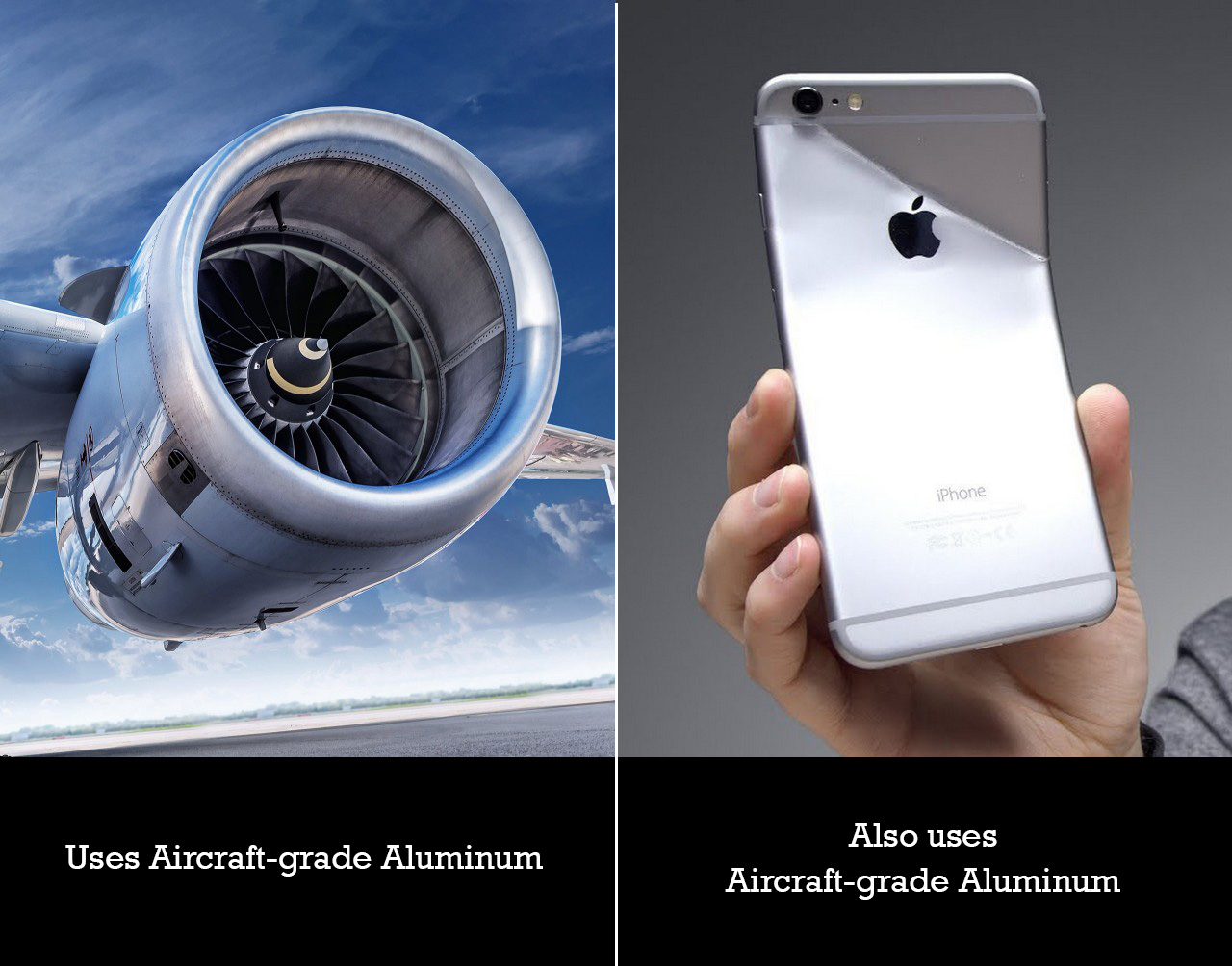
I’m not entirely sure if I attribute this to Apple, but I definitely heard the words ‘aircraft-grade’ aluminum for the first time in an Apple keynote. I remember this because I also distinctly remember how I felt hearing those words. My first gut reaction was to imagine Apple sourcing its aluminum from the creme-de-la-creme of resources, using the same metal that would otherwise be found in airplanes, fighter jets, and potentially even rockets.
It wasn’t long before ‘aircraft-grade’ and its fancier sibling ‘aerospace-grade’ became a common part of marketing vocabulary, and eventually general vocabulary too. EDC and other items made with materials like aramids, carbon fiber, or Kevlar would also use terms like ‘military-grade’ to indicate that they were built for resilience, to take on the brunt of literal war. Turns out, however, that these marketing terms are exactly that… “marketing terms”. The phrases ‘aircraft-grade’ and ‘military-grade’ may sound like they’re indicators of incredibly high quality, but the problem lies in their absolute ambiguity. There’s really no fixed definition or standard for what’s ‘aircraft-grade’ or what qualifies as ‘military-grade’, and more importantly, there isn’t a body that really enforces any of these standards. Other standards like IP ratings for dust and water protection are regulated and enforced by bodies like the International Electrotechnical Commission (IEC), but terms like “eco-friendly” and “ethically sourced” are hardly enforceable standards. They have no logical, measurable definition. Terms like ‘military-grade’ and ‘aircraft-grade’ fall pretty much into the same trap. A $20 Smith & Wesson pocket knife and a $2,000 MacBook could both be made using aircraft-grade aluminum. However, there’s absolutely no way of guaranteeing that both materials are of the exact same quality. Let’s dive in…
What exactly DO ‘Military-Grade’ and ‘Aircraft-Grade’ mean?
Here’s the kicker. To consumers, these terms mean absolutely, quantifiably NOTHING. Sure, to the US Military, and to the FAA, the standards matter a lot… but then again, the military doesn’t really buy its gear off of Amazon or Kickstarter, does it? When used by manufacturers or retailers in military contracts, the phrase “military grade” tends to refer more specifically to materials manufactured according to United States Military Standard (MIL-STD) specifications—a set of engineering and durability requirements developed by the U.S government which must be met before any item can qualify as being suitable for use by their armed forces personnel. Similarly, with “aircraft-grade” materials and components; certain parts must meet strict requirements set by aviation authorities before being installed on planes (such as FAA regulations), but these requirements apply to the material themselves and not really the component made using these materials. For example, even though the iPhone 6 was made using ‘aircraft-grade’ aluminum, it practically folded like a lawn chair in people’s pockets, creating the entire ‘Bendgate’ controversy.

Here’s where things get even more confusing…
There are a few pretty large loopholes that create enough wiggle room for companies to throw blanket terms on their products, calling them military-grade or aircraft-grade. The first is with materials – A product could use Dupont’s Kevlar in it and dub itself as Military Grade because the military does, in fact, use Kevlar in their protective vests. However, that doesn’t mean said product is military grade. It just means the material it’s using is military-grade. The product could still have a faulty design with points of failure. It’s pretty much the same story with the Bendgate iPhone. There are a lot of grey areas with airspace-grade parts too because aircrafts are incredibly large vehicles, and even the metal used for the belt buckle in the passenger seat can be dubbed as ‘aircraft-grade’, but use that same buckle metal to make the plane’s fuselage and it would fail almost instantly. The vice versa wouldn’t make any sense either, right? Similarly, different planes have different requirements. A fighter jet and a commercial aircraft have a rather small overlap when it comes to materials, specifications, and engineering. Drones classify as aircrafts too, making matters even more complicated, because drones won’t use the same quality of materials as a stealth-fighter. However, both could use materials that are certified as ‘aircraft-grade’.
That logic carries forward to the ‘military-grade’ argument too, and with a wider scope of debate. The word military could pretty much apply to any military, couldn’t it? When a product says ‘military-grade’ without any further elaboration, it could just as easily be certified for use by the American military as it could be by the Madagascar military. The two don’t really compare at all. Moreover, aside from USA and Madagascar having completely different capabilities and sizes, they have different budgets too. Certain militaries will try to cost-cut by going for the second or third-best alternative or with the lowest bidder. They might even just buy military-grade gear that’s from a few decades ago – a great example is the M16 rifle, which was officially used by the US military since 1963 (most famously in the Vietnam war). The US military phased it out in 2015, upgrading to the M4 carbine instead, but the M16 is still procured, modified, and used by a bunch of other countries. You see where I’m going with this, don’t you? To put it concisely, the term military grade could really mean any military or even any era… and not every single military has the best gear. So what does that say about your gadget?

How marketing teams benefit from this confusion
There’s a fair chance that a small, yet pretty sizeable chunk of companies is legitimately using terms like “military-grade” or “aerospace-grade” (or even “medical-grade”, although that really calls for a separate article) with complete honesty and integrity. The inverse, unfortunately, is overwhelmingly true too. There’s no real way to measure the ‘military-grade-ness’ of a product without actually verifying that military personnel actually use it… and the last thing a military outfit would do is reveal the bleeding-edge tech they use. There’s no authoritative body that will verify whether consumer products are legitimately military-grade or not, and you can’t particularly sue a company for making the claim too, because it’s all really incredibly ambiguous.
This really opens up the market for companies looking to throw flashy words around to make their products sound durable, safe, or legit. A lot of times, they’re right, and a lot of times they’re dead wrong. As a blog, we’ve written lengthy articles about a product claiming to be military-grade or aerospace-grade, but having a warranty of just one or maybe two years. Doesn’t add up, right?! What military or airline would use a product that only guarantees to work for a maximum of two years?? Are blogs like ours to blame? I guess you could say so, but we’re also beholden to press releases that mention these words. Our bigger goal at this point is to weed out companies that don’t have a reputation for making great products. Everyone uses these terms, I guess the part where we come in is in measuring the reliability and history of the company before we write our piece. In a way, this article also serves its purpose of enabling you, the reader, to make more informed choices.
The Most Effective Solution (Hint: You won’t like it)
So how do we all collectively fix this problem? The truth is, we can’t do anything collectively. There will always be a handful of companies and marketing teams that ‘maliciously’ use vague words to indicate reliability and durability. There’s nothing we can do to really stop them from doing so. What blogs, however, can do is try to curate more responsibly (you’ll never see us hawking unbranded products from AliExpress or Wish.com), and be more forthcoming with the information we share with you.
The more effective solution, however, lies in the hands of readers and consumers like you. Prioritize human reviews, actual certifications, warranty details, pricing, and brand reliability before buying a product. In the same way that we’ve all developed an ability to identify fake news, doctored images, deep fakes, and AI-generated content on the internet, it helps to also be able to filter out marketing-speak from information-driven blogging.
Read Next: Nobody knows how Damascus Steel was originally made… all we can do is guess
The post Terms like ‘military-grade’ and ‘aircraft-grade’ are NOT indicators of good quality. Here’s why first appeared on Yanko Design.

0 Commentaires